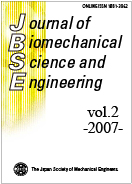All issues

Volume 2, Issue 1
Displaying 1-4 of 4 articles from this issue
- |<
- <
- 1
- >
- >|
Papers
-
Bijay GIRI, Shigeru TADANO, Kazuhiro FUJISAKI, Masahiro TODOH2007Volume 2Issue 1 Pages 1-11
Published: 2007
Released on J-STAGE: January 23, 2007
JOURNAL FREE ACCESSNaturally occurring holes in bone called foramina are not detected as region of crack initiation or growth. Lumbar vertebrae, which are subjected to complex external loads, have considerable number of such big and small foramina. The mechanical characteristics of bone profoundly depend on the mineral content (HAp crystals) and collagen fibers alignment, where c-crystallographic axis of HAp crystals are preferentially oriented parallel to the long axis of collagen fibers. In the current work, we investigated the crystal orientation and mineral distribution around the foramen using X-rays to explore the reason of foramen not being region of crack initiation or growth to the precise level. Specimens were harvested from bovine lumbar vertebrae. The orientations of HAp crystals were determined from the diffracted intensity profile of X-rays using imaging plate. Mineral fractions were measured from the fraction of X-rays transmitted through the specimen. The tangential orientation of the crystals revealed around the foramen edge was considered as the main reinforcing parameter for the foramen. The minerals were distributed in the specimen without any predictable tendency. Hence, they were not considered as a strengthening parameter. A thicker cortical region was discovered near the surface around the upper edge of the foramen, which was also extended within the cancellous mass as a thin cylindrical cortical shell covering the foramen from inside. Such structures were regarded to result the foramen a damage resistant site.View full abstractDownload PDF (2805K) -
Takuji ISHIKAWA, Nobuyoshi KAWABATA, Yohsuke IMAI, Ken-ichi TSUBOTA, T ...2007Volume 2Issue 1 Pages 12-22
Published: 2007
Released on J-STAGE: February 09, 2007
JOURNAL FREE ACCESSThe blood flow in a large artery is commonly analyzed by means of constitutive equations. However, it is not appropriate to use these equations for small arteries because of the heterogeneity of the blood. In this study, we use a bead-spring model for an erythrocyte to simulate a low-hematocrit blood flow in a small artery with a stenosis. The flow field is solved using Euler coordinates, whereas the motion of the erythrocyte is solved using Lagrangian coordinates (two-way coupling). The results show that the erythrocytes are considerably deformed around the stenosis and that the separated region downstream of the stenosis is weakened by the erythrocytes.View full abstractDownload PDF (783K) -
Takeki YAMADA, Yoshihisa KOYAMA, Tomoyuki KAWAI, Takeshi MUNETA, Kazuo ...2007Volume 2Issue 1 Pages 23-33
Published: 2007
Released on J-STAGE: April 10, 2007
JOURNAL FREE ACCESSLigament reconstruction with the use of novel demineralized bone grafts was investigated in a rabbit model. By demineralizing only the central portions of the long bone samples, the grafts had a configuration of the bone-tendon-bone graft and were flexible in bending. Strip type grafts made from femur, stick type grafts from tibia, and tube type grafts from metacarpal bones were prepared and their performances were evaluated by tensile testing and animal experiments for medial collateral ligament (MCL) and anterior cruciate ligament (ACL) reconstruction. The maximum strength of the strip and stick type grafts were about half of that of MCL, and that of tube type grafts was also about half of that of ACL. The survival rate of strip type grafts in MCL reconstruction was about 50%, and that of stick type was about 60%. In ACL reconstruction, the survival rate of strip type grafts was 0%, that of stick type was 10%, whereas that of tube type grafts was 50%, and that of tube type grafts reinforced with suture was 60%. The strip and stick type grafts might be useful for MCL reconstruction and the tube type grafts might be available for ACL reconstruction with suitable reinforcements.View full abstractDownload PDF (964K) -
Koichiro YANO, Daisuke MORI, Ken-ichi TSUBOTA, Takuji ISHIKAWA, Shigeo ...2007Volume 2Issue 1 Pages 34-44
Published: 2007
Released on J-STAGE: April 17, 2007
JOURNAL FREE ACCESSStokesian dynamics method based on the approximation of the additivity of velocities was employed to analyze the mechanical behavior of the primary thrombus under the blood flow. The mechanical interactions in the platelet-platelet aggregation and the platelet-surface adhesion via biological macromolecules such as von Willebrand factor and fibrinogen was modeled by the Voigt model. The process of the primary thrombus destruction was simulated under different levels of the mechanical interaction using the developed method. When the binding force was weak, which corresponds to the decline of the platelet function in the bleeding diseases, it was demonstrated that the platelets did not efficiently reside on the injured site of the vessel wall. The results show that our modeling can qualitatively demonstrate the effect of the mechanical interaction via adhesive macromolecules on the destruction process of the primary thrombus. Our modeling could be a powerful tool to better understand the physiological hemostatic mechanism as well as the pathology of the thrombosis and the bleeding disorders.View full abstractDownload PDF (568K)
- |<
- <
- 1
- >
- >|